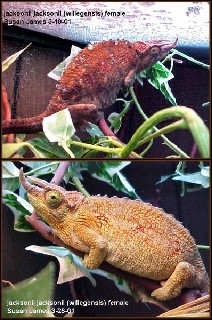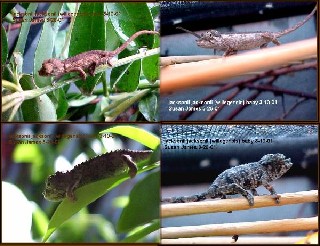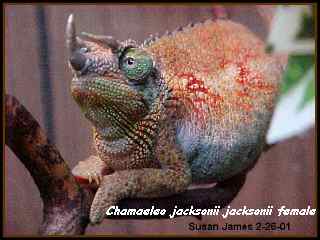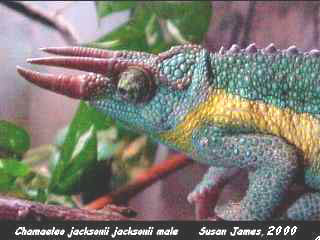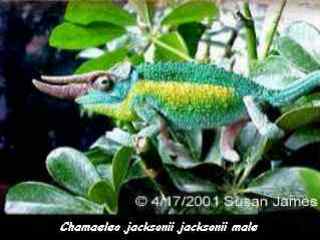 |
|
| Chamaeleo
(Trioceros) jacksonii jacksonii |
| Scientific name |
Common name(s) |
alternate scientific names |
described by |
year |
size |
brood |
|
Chamaeleo
(Trioceros) jacksonii jacksonii
|
Jackson's Chameleon |
Chamaeleon jacksoni, Chamaeleon jacksoni jacksoni, Chamaeleon jacksoni vauerescecae, Chamaeleo jacksonii
willigensis.
see a species list of Chamaeleo
|
Boulenger |
1896 |
Medium |
Live |
The nominate form of C. jacksonii is abundant in the mid-elevation rain forests and agricultural lands of Mount Kenya, Kenya and possibly the Usambara and Aberdare Mountains of Tanzania. Males grow to 10 inches total length (SVL 4-5 inches). Females are slightly smaller. Males are highly aggressive toward conspecifics but generally timid toward keepers.
Some specimens of C. j. jacksonii have been erroneously classified as C. j. "willegensis". The designation "willegensis" was reportedly the name given given to a smuggled shipment of C. jacksonii which was seized by the Dutch authorities. Not knowing the origin of the shipment, they named the putative subspecies after the alleged smuggler. For some reason, the name C. j. "willegensis" stuck but this was never a formal scientific designation and
taxonomists now consider C. j. "willigensis" to be within the range of variation of the nominate form, C. j. jacksonii (R. Pilley, personal communication. For additional information on this issue see http://www.adcham.com/html/taxonomy/articles/status-cjwilli.html
The description of C. j. jacksonii is similar to that for C. jacksonii xantholophus except for the following differences:
- The size of C. j. jacksonii falls between that of the larger xantholophus and smaller merumontanus.
- Female C. j. jacksonii have a well developed rostral horn. The female's preocular horns vary from absent to well developed.
- Scale pigmentation on the parietal and dorsal crests are similar to merumontanus and darker than xantholophus. Source: Abate, A. and Kalish, K., CiN Issue 14, Winter, 1994). Additionally, C. j. jacksonii tends to have a "rougher" parietal crest, unlike that of merumontanus and xantholophus which tend to be somewhat smooth. Male horns, especially the rostral, appear to be darker in color and thicker than that of meru and xant.
Males of all three subspecies (merumontanus, jacksonii and xantholophus) have well developed, annulated preocular and rostral horns. Males exhibit a tail base swelling.
Male coloration is an overall light green with a yellow stripe along the flank. A splash of light blue can be seen on the head and tail base. Coloration of the form formerly know as "willegensis" is blue on the head and green on the top part of the body with a canary yellow band on the flank that can extend from the gular region to the tail base. There is blue on the belly and their tails are dark green with blue spots. Female coloration ranges from dark olive to light green. Female horn development varies within each clutch from a single rostral horn to 3 developed horns.
Because this subspecies is rarely seen in captivity little is known for certain about their husbandry and reproduction. It assumed that their requirements are very similar to those of C. j. xantholophus. However, they generally give birth to a single clutch per year. Each clutch has from 6-35 live young and sexual maturity occurs at approximately 5 months.
References
Bartlett, R. D. and Bartlett, P. 1995.
Chameleons: A Complete Pet Owner's Manual.
Barron's Educations Series, Hauppuage, NY
Davison, Linda J. 1997. Chameleons: Their Care and Breeding.
Hancock House Publishers, Blaine, WA.
De Vosjoli, P. 1998. Preliminary obsevations on intraspecies communication in the Jackson's chameleon.
Chameleon Information Network # 28, 16-25.
De Vosjoli, P. and Ferguson, G. 1995.
Care and Breeding of Chameleons. Advanced Vivarium Systems, Santee, CA.
Klaver, C. & W. Boehme. 1997. Chamaeleonidae.
Das Tierreich, 112: i-xiv' 1 - 85. Verlag Walter de Gruyter & Co., Berlin, New York.
Le Berre, F. 1994. The New Chameleon
Handbook. Barron's Educational Series.
Martin, J., 1992. Masters of Disguise: A Natural History of Chameleons. Facts On File, Inc., New York, NY.
Necas, P. 1999. Chameleons: Nature's Hidden Jewels.
Krieger Publishing Company, Malabar, FL.
Schmidt, W., Tamm, K. and Wallikewitz, E. 1994a.
Chameleons, Volume I: Species. T.F.H. Publications, Neptune City, NJ. Schmidt, W., Tamm, K. and Wallikewitz, 1994b.
Chameleons, Volume II: Care and Breeding. T.F.H. Publications, Neptune City, NJ.
Spawls,
S., Howell, K., Drewes, R., and
Ashe, J. 2002. A Field Guide
to the Reptiles of East Africa.
Academic Press, New York.
|
|
|
|
|
click on any thumbnail for a larger image
|
|
This page last modified on: Wednesday, November 27, 2002
|
© 2002-2005 ADCHAM.com
ADCHAM logo illustrated by Randy Douglas. Web site design by Look Design, Inc.
Do not reproduce or redistibute any of content of this web site without express written permission from the authors.
|
|
|

